| Pages:
1
2 |
Boffis
International Hazard
    
Posts: 1843
Registered: 1-5-2011
Member Is Offline
Mood: No Mood
|
|
Preparation of Ketones by Calcium salt Pyrolysis
3-Pentanone by the pyrolysis of Calcium Propanoate
18th April 2023 Boffis
Over the years the preparation of ketones by the pyrolysis of various metal salts has been much discussed on the SM site but very few successful
procedures with experimental details have ever been posted. This thread is an attempt to rectify this situation.
I recently required some 3-pentanone (Diethyl ketone) for another experiment and after considering the various options I decided to try the calcium
propanoate pyrolysis route. I chose this preparation method as it is a simple procedure and the starting material is both easily available and cheap.
There are numerous related procedures in the published literature, particularly the older literature, and numerous studies on mechanisms and thermal
decomposition rates etc. but the more recent papers are often on a minute scale of little preparative value or using equipment not readily available
to amateurs.
I wasn’t sure how a glass flask would stand up to the temperature required but equally using a metal retort meant that I couldn't see what was going
on inside the retort. In the end I decided to use some large Pyrex test-tubes of 200 by 28 and 200 by 32mm. The 28mm diameter tube holds about 18g per
charge and the 32mm tube a little over 20g per charge. To my surprise the test-tube are easily cleaned and if the heating has been done carefully they
are practically as good as new after a washing with dilute hydrochloric acid. A typical run of 20g in a 32mm test-tube requires about 12-14minutes
heating and yields about 8g of pale straw-coloured distillate. After standing for 24 hours a very small amount of water separates out which is easilt
separate before distillation.
Experimental
The batch consisted of 10 individual runs of 18-20.4g, a total of 190.6g calcium propanoate were used.

Fig. 1 The general equipment set-up used for the pyrolysis
A typical run was as follows:
A large 200mm test-tube was roughly ⅔ filled with loose calcium propanoate powder and shaken down. The test tube was mounted at about 20° to the
horizontal and fitted with a bung equipped with a sharply bent delivery tube so that its free end is practically vertical. A small bung is used on the
other end to fit it to a Liebig condenser arranged vertically. The lower end of the condenser passing well into a small conical flask, pre-weighed if
you are interested in the yield.
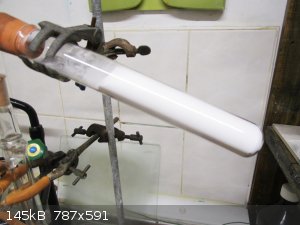
Fig. 2 The charged retort test tube.
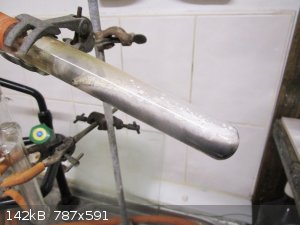
Fig. 3 The exhausted retort.
The tube was heated with Bunsen burner, gently at first by playing the burner over the whole length of the tube below the clamp until slight melting
of the charge is noticed and then the tube is heated from the top of the charge. As the charge is heated it begins to melt, then froths very slightly
and shrinks away to a clinker-like mass. The burner is worked over the entire charge length periodically to keep the whole tube hot to minimise
thermal stress on the test-tube. Heating is continued until all of the charge has shrunk down and stopped intumescing, then the burner is slowly
removed. The tube should never glow even slightly red. Too rapid heating results in charring and reduces the yield.
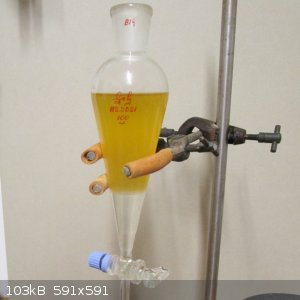
Fig. 4 The condensate after 24 hrs in a separating funnel showing the aqueous lower layer.
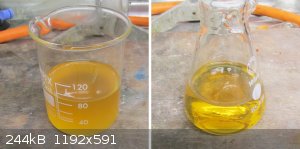
Fig. 5 The condensate after removal of the aqueous phase circa 85ml and post drying
When the tube had cooled sufficiently to allow handling it was replaced by a fresh pre-filled tube and the process repeated. 10 charges were used to
give sufficient to raw condensate to be able to work-up easily. The resulting condensate was allowed to stand overnight and then the aqueous phase
removed in a small separating funnel. The light, pleasant smelling, straw coloured organic phase was then dried with sodium sulphate, filtered and
distilled in a 100ml pear shaped flask using a 25cm by 1.5cm Vigreux column. Distillation began at about 80° and about 5-6m passed over between 80
and 83°, this appears to be a azeotrope of 3-pentanone and water, indicating inadequate drying. The temperature then rises fairly rapidly to about
100°. The ketone (Bp 102°) was collected between 100 and 102° as a clear, colourless, typically “ketone” smelling liquid. About 4ml of brown
residue remained in the flask.
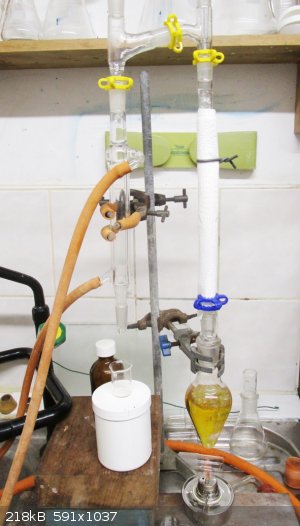
Fig. 6 The general set-up for the fractional distillation of the dried ketone
The roughly 8ml of low boiling fraction separated into a small aqueous phase and wet ketone. It was kept and will be added to the next batch after
further drying.
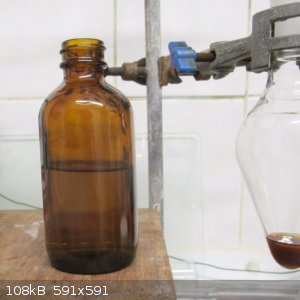
Fig 7. The final distilled product in a pre-weighed 125ml capacity bottle.
The main fraction of distillate was collected in a pre-weighed 125ml bottle, the weight collected was 64.68g or about 73.3% of theory. There is
probably about another 5-6g of ketone in the low boiling fraction so the final yield could be almost 80% which, for a pyrolytic process, is excellent.
|
|
|
clearly_not_atara
International Hazard
    
Posts: 2722
Registered: 3-11-2013
Member Is Offline
Mood: Big
|
|
Preparative scale, good yield, awesome pictures. Featured paper for Acta Chemica Libera if we were ever actually going to do it.
And thanks for riding to the rescue of my blabbering about calcium salt pyrolysis in the fluorobenzoate thread 
|
|
|
SplendidAcylation
Hazard to Others
  
Posts: 199
Registered: 28-10-2018
Location: Starving in some deep mystery
Member Is Offline
Mood: No one I think is in my tree.
|
|
What a coincidence! While refluxing some iron powder with benzoic acid and acetic acid in a test-tube, in order to prepare acetophenone, I decided to
check in here, and look what I found! 
Another fantastic write-up, the yield is quite impressive.
|
|
|
Boffis
International Hazard
    
Posts: 1843
Registered: 1-5-2011
Member Is Offline
Mood: No Mood
|
|
Thanks for the comments guys! I am working on a prepublication write-up at the moment and a second batch of 12 runs or roughly 240g, I have got to run
8 today, I'll finish off tomorrow. I finished off the bought calcium propanoate at run 6 and then started using my own salt, an interesting
observation I have just made is that while the bought flour additive material is very fine and low density whereas my homemade calcium propanoate is
much denser and it is possible to use 30g per run as a result. I am collecting data for every run so in the end I should be able to see if there is a
difference in yield.
I like the idea of an SM online journal of quality preparations and experiments. I do a lot more experiments and preps than I post here but don't post
them because no one seems interested in some of the fields that I am interested in.
@SplendidAcylation. Did your iron filings + benzoic acid and acetic acid work? I found a synthesis of di-n-propyl ketone (4-heptanone) on the Org Syn
web site that uses a similar technique basically distilling butanoic acid with iron powder. I am going to try the calcium butanoate pyrolysis (a
bottle of v. smelly butanoic acid arrived today) but I might also give the OrgSyn method a whirl and see how it compares. I also plan to try a half
aromatic Ca salt pyrolysis possibly benzoate and propanoate to get propiophenone just for the experience.
|
|
|
kmno4
International Hazard
    
Posts: 1495
Registered: 1-6-2005
Location: Silly, stupid country
Member Is Offline
Mood: No Mood
|
|
I always liked this way of preparing ketones. One of my earliest experiments was thermal decomposition of Ca acetate in RBF. Unfortunately, some CaCO3
partly melted into the glass..... 
Nevermid. I think it is very universal way for preparing many ketones of different kinds, today slighly forgotten. In most cases, the yields are good
or very good. Many metallic salts can be used: Ca, Ba, Mg, Zn, Mn (II), Fe (II), Pb ..... They say that the best results are obtained for the least
thermally stable salts and for metalas giving the least stable carbonates. However, Ca salts are the cheapest ones, Ca also has low molar mass. I
remember preparation of benzophenone from Zn benzoate in SS pipe - unfortulately it melted before and during decomposition, it caused many problems

But some (C5H5)CO was prepared in this way.
Performing such thermal decompositions under reduced pressure gives excellent results: the yields of ketones are better and temperature of reaction
may be greatly reduced (usually more than 100 C less)
Anyway - good luck in further old-school experiments 
Слава Україні !
Героям слава !
|
|
|
Texium
Administrator
       
Posts: 4546
Registered: 11-1-2014
Location: Salt Lake City
Member Is Offline
Mood: PhD candidate!
|
|
Excellent write-up, as usual, Boffis!
I still want to! If
it wasn't for needing a "real" job for money and health insurance, I would make the journal, the wiki, and the deconvolution of the sticky threads my
full-time directive.
|
|
|
Mush
National Hazard
   
Posts: 633
Registered: 27-12-2008
Member Is Offline
Mood: No Mood
|
|
Brilliant! Excellent write-up.
[Edited on 19-4-2023 by Mush]
|
|
|
tyro
Harmless

Posts: 31
Registered: 22-12-2021
Member Is Offline
|
|
Thanks for this! I've been interested in pyrolysis reactions in the past. Great to see some well-documented examples.
What are your plans for the 3-pentanone?
|
|
|
SplendidAcylation
Hazard to Others
  
Posts: 199
Registered: 28-10-2018
Location: Starving in some deep mystery
Member Is Offline
Mood: No one I think is in my tree.
|
|
Quote: Originally posted by Boffis  |
@SplendidAcylation. Did your iron filings + benzoic acid and acetic acid work? I found a synthesis of di-n-propyl ketone (4-heptanone) on the Org Syn
web site that uses a similar technique basically distilling butanoic acid with iron powder. I am going to try the calcium butanoate pyrolysis (a
bottle of v. smelly butanoic acid arrived today) but I might also give the OrgSyn method a whirl and see how it compares. I also plan to try a half
aromatic Ca salt pyrolysis possibly benzoate and propanoate to get propiophenone just for the experience. |
Yes! It appears to work, I am still very much in the early stages of investigating this process though 
I mixed 1g benzoic acid, 0.5g iron powder, and 0.5g acetic acid in a test-tube, and heated it on a sand-bath at 250c, with a glass tube fitted to act
as a reflux condenser.
A rubber tube was attached to the top of the glass tube and led into an inverted cylinder full of water to measure the volume of hydrogen evolved.
The reduction was slow, but steady. The theoretical volume of hydrogen produced should have been about 180mL, I collected 90mL within the first hour
of refluxing, and another 60mL over the next two hours.
At this point I had collected 150mL, so I figured the reaction had progressed sufficiently for this experiment, so I switched it off and swapped the
glass condenser tube with a bent glass tube to act as a distillation condenser, basically like a retort.
The test-tube, now containing a mixture of black, brown, and dark-green salts, was then heated strongly with the Bunsen burner; This initially
resulted in some white mist coming over, then the ketone began to distill over as an amber liquid.
Around 0.5mL of distillate was obtained.
This was then washed with sodium bicarbonate solution, resulting in significant fizzing due to the presence of unreacted acetic and benzoic acids,
probably.
The oily upper layer was then diluted in ether, dried over MgSO4, and the ether evaporated, yielding about 0.18g of a yellow liquid with a pleasant
smell.
I'd say the smell is somewhat similar to phenethyl alcohol, styrene, and benzaldehyde 
So this is a roughly 20% yield, not great, but pretty acceptable for such a small-scale reaction (of course the yield will drop somewhat when the
crude ketone is further purified by distillation, but still...)
So the preliminary observations are as follows:
The reduction of the acids with iron powder is much slower than the literature states
Temperature control is necessary to ensure the reaction progresses smoothly
I tried the same thing without proper temperature control, i.e. just heating the mixture of iron and acetic and benzoic acid with the Bunsen burner,
but this wasn't very successful, as the poor temperature control results in overlap between the reduction of the acids by the iron, and the
decomposition of the iron salts thus formed, by the action of heat.
Oh, also, the gas produced was indeed hydrogen, as confirmed by a loud pop when a flame was placed in proximity of the inverted cylinder! 
The next step shall be to scale up the reaction, I have come across a nice fused quartz test-tube which should do nicely for the reaction!
[Edited on 24-4-2023 by SplendidAcylation]
|
|
|
Fery
International Hazard
    
Posts: 1001
Registered: 27-8-2019
Location: Czechoslovakia
Member Is Offline
|
|
Boffis as well SplendidAcylation well done both experiments!
SplendidAcylation - reacting Ca benzoate + Ca propionate should yield propiophenone, it has nice scent too. Or salts with different cation as you did
(Fe). Both aceto as well propio scent best at very low concentrations.
|
|
|
SplendidAcylation
Hazard to Others
  
Posts: 199
Registered: 28-10-2018
Location: Starving in some deep mystery
Member Is Offline
Mood: No one I think is in my tree.
|
|
Quote: Originally posted by Fery  | Boffis as well SplendidAcylation well done both experiments!
SplendidAcylation - reacting Ca benzoate + Ca propionate should yield propiophenone, it has nice scent too. Or salts with different cation as you did
(Fe). Both aceto as well propio scent best at very low concentrations. |
Well the results are only preliminary at this point 
I am scaling up the procedure, and I have so far discovered that the reaction between iron and benzoic acid + acetic acid is slow.
The paper says hydrogen evolution should be complete within 45 minutes at 250c.
I am now running it at 290c, and I expect it will take a total of 6 to 8 hours to achieve a quantitative yield of hydrogen! 
You are spot on about the scent, though!
Acetophenone just kinda smells like benzaldehyde, or toluene, or something like that, in high concentrations, but when diluted it has a wonderful
flowery smell!
|
|
|
Boffis
International Hazard
    
Posts: 1843
Registered: 1-5-2011
Member Is Offline
Mood: No Mood
|
|
Hi Guys, thankyou for the comments. I have been busy making calcium salts of butanoic acid etc (very smelly business!!) for my next experiments in
this vein.
SlendidAcylation. What sort of iron powder did you use? I notice in the Org Synth procedure they use "hydrogen reduced" iron powder which i presume
has a high surface area and is vey fine grained. I looked at this procedure too and may give it a go but I am going to buy some reduced iron powder. I
have found a couplke of ebay suppliers who sell possibly suitable material ("carbonyl" reduced and atomised iron powder respectively). I am just
working up the crude product from a calcium acatate/ calcium phenylacetate batch. I used a large excess of acetate to minimise the production of
dibenzyl ketone which due to its high boiling point I would expect to carbonise extensively so I was expecting a lot of acetone. Interestingly while I
got plenty of distillate it doesn't smell much of acetone.
I am just about ready to try my calcium butanoate tonight.
While rummaging through my box of calcium salts I found some calcium beta hydroxybutanoate and some calcium lactate. This made me wonder what would
happen if I pyrolysed say the calcium lactate. In theory you should get 2,4-dihydroxy-3-pentanone but I can't believe this would survive the pyrolysis
as it would surely dehydrate to divinyl ketone. I looked up the properties of divinyl ketone and it doesn't sound that stable either. However, in the
presence of a strong lewis acid it cyclotises to cyclopentenone. I wondered if this might happen under the conditions of pyrolysis. Anyone any
thoughts on this?
|
|
|
SplendidAcylation
Hazard to Others
  
Posts: 199
Registered: 28-10-2018
Location: Starving in some deep mystery
Member Is Offline
Mood: No one I think is in my tree.
|
|
Quote: Originally posted by Boffis  | Hi Guys, thankyou for the comments. I have been busy making calcium salts of butanoic acid etc (very smelly business!!) for my next experiments in
this vein.
SlendidAcylation. What sort of iron powder did you use? I notice in the Org Synth procedure they use "hydrogen reduced" iron powder which i presume
has a high surface area and is vey fine grained. I looked at this procedure too and may give it a go but I am going to buy some reduced iron powder. I
have found a couplke of ebay suppliers who sell possibly suitable material ("carbonyl" reduced and atomised iron powder respectively). I am just
working up the crude product from a calcium acatate/ calcium phenylacetate batch. I used a large excess of acetate to minimise the production of
dibenzyl ketone which due to its high boiling point I would expect to carbonise extensively so I was expecting a lot of acetone. Interestingly while I
got plenty of distillate it doesn't smell much of acetone.
I am just about ready to try my calcium butanoate tonight.
While rummaging through my box of calcium salts I found some calcium beta hydroxybutanoate and some calcium lactate. This made me wonder what would
happen if I pyrolysed say the calcium lactate. In theory you should get 2,4-dihydroxy-3-pentanone but I can't believe this would survive the pyrolysis
as it would surely dehydrate to divinyl ketone. I looked up the properties of divinyl ketone and it doesn't sound that stable either. However, in the
presence of a strong lewis acid it cyclotises to cyclopentenone. I wondered if this might happen under the conditions of pyrolysis. Anyone any
thoughts on this? |
 Butanoic acid is horrific. Butanoic acid is horrific.
I used carbonyl iron, it is an extremely fine, black powder.
I noticed something strange; Once I had collected around 500mL of hydrogen, I ignited it (just for fun!), and while the hydrogen burned with the usual
"pop", something else continued to burn for a few seconds inside the graduated cylinder.
When the cylinder was oriented with the opening facing upwards it continued to burn, so it definitely wasn't hydrogen, as that would have escaped, and
besides, I don't think hydrogen is capable of burning quietly like that.
So I'm not really sure what it is, perhaps some acetic acid might have made its way into the cylinder, carried as vapour along with the hydrogen, but
I would have expected it to dissolve in the water through which it was bubbled...
Anyway, I have collected around 75% of the theoretical hydrogen, which took over six hours of heating, so I don't think I'll bother spending another
six hours to obtain the final 25%, instead I'll try distilling the iron salts today and see what I get 
|
|
|
Boffis
International Hazard
    
Posts: 1843
Registered: 1-5-2011
Member Is Offline
Mood: No Mood
|
|
I have just finished a couple of runs with calcium butanoate and got a little pleasant minty smelling material, so it seems like some success but the
salt responds differently to those I have already tried. It melts and then foams, the foam expands considerably blocking the retort tube and seems to
prevent the ketone from escaping. When the tube has cooled the soft foam is easily removed but is "moist" with ketone. I am currently trying to
recover the ketone from the foam by stem distillation. The calcium butanoate foam persists were as those produced by propanoate and
phenylacetate/acetate collapse when exhausted leaving a conduit along the retort. Furthermore, calcium butanoate etches the tubes were as the other
salts don't. This may indicate a higher decomposition temperature.
These issues may be the reason the Org Synth procedure uses the ferrous salt pyrolysis, lower decomposition temperature, less aggressively alkaline
slag, less foaming; maybe.
|
|
|
Organikum
resurrected
    
Posts: 2330
Registered: 12-10-2002
Location: Europe
Member Is Offline
Mood: frustrated
|
|
Quote: Originally posted by SplendidAcylation  | Quote: Originally posted by Fery  | Boffis as well SplendidAcylation well done both experiments!
SplendidAcylation - reacting Ca benzoate + Ca propionate should yield propiophenone, it has nice scent too. Or salts with different cation as you did
(Fe). Both aceto as well propio scent best at very low concentrations. |
Well the results are only preliminary at this point 
I am scaling up the procedure, and I have so far discovered that the reaction between iron and benzoic acid + acetic acid is slow.
The paper says hydrogen evolution should be complete within 45 minutes at 250c.
I am now running it at 290c, and I expect it will take a total of 6 to 8 hours to achieve a quantitative yield of hydrogen! 
You are spot on about the scent, though!
Acetophenone just kinda smells like benzaldehyde, or toluene, or something like that, in high concentrations, but when diluted it has a wonderful
flowery smell!
|
Magnetite, the paramagnetic black iron oxide works much better in the dry distillation process and it is easily prepared from the calculated amounts
of Fe(II) and Fe(III) chloride in lots of hot (80 °C) very diluted HCl and then dropwise adding Ammonia or NaOH whilst mad stirring. A magnet in a PE
bag with a string can be used to collect the product directly and such much bigger amounts can be made keeping the reaction volume reasonable.
The nanoparticles produced this way seem to be next to ideal although I am not even sure if they react directly or only at elevated temperatures.
Sodium Benzoate + carboxylic acid + magnetite (thoroughly mixed as a slurry) works also very well, calcium salts require much higher temperatures and
yields are therefor not good generally.
good luck!
/ORG
|
|
|
Boffis
International Hazard
    
Posts: 1843
Registered: 1-5-2011
Member Is Offline
Mood: No Mood
|
|
@ Organikum, is this from personal experience or do you have a reference to the magnetite procedure? I am finding that the calcium butanoate etches
the glass test tubes were as the other calcium salts didn't, so this procedure may be a useful alternative. At the moment I am trying a lower
temperature decomposition (slow) and then extracting the ketone from the ash with acetone (steam distillation didn't work!).
|
|
|
Fery
International Hazard
    
Posts: 1001
Registered: 27-8-2019
Location: Czechoslovakia
Member Is Offline
|
|
Boffis, interesting experiments, I hope you defeat the difficulties soon. Couldn't the product be distilled using vacuum distillation ? Only water
aspirator vacuum pump level as b.p. of 4-heptanone at atm. pressure is 144 C (to be able to condense). No stirring as the reaction gave solid mixture
and the solid should facilitate the liquid product evaporation without bumping? IIRC somewhat more poisonous barium salts decarboxylate at a little
lower temperatures (maybe butyric acid could be directly reacted with BaCO3 - fresh BaCO3 or BaCO3 recovered from previous decarboxylation)? IIRC also
manganese salts decarboxylate at somewhat lower temperatures than Ca salts. But Fe butyrate seems to be cheapest and most available for home lab.
Couldn't be Ca butyrate some hydrate instead of anhydrous (because of foaming - just guessing, but the more carbons in chain the less hydrophilic so
in theory butyrate should be less hygroscopic than propionate) ?
good scents company describe 4-heptanone scent as fruity, cheesy, sweet, tutti-frutti, cognac, pineapple
http://www.thegoodscentscompany.com/data/rw1025681.html
|
|
|
SplendidAcylation
Hazard to Others
  
Posts: 199
Registered: 28-10-2018
Location: Starving in some deep mystery
Member Is Offline
Mood: No one I think is in my tree.
|
|
Quote: Originally posted by Organikum  | Quote: Originally posted by SplendidAcylation  | Quote: Originally posted by Fery  | Boffis as well SplendidAcylation well done both experiments!
SplendidAcylation - reacting Ca benzoate + Ca propionate should yield propiophenone, it has nice scent too. Or salts with different cation as you did
(Fe). Both aceto as well propio scent best at very low concentrations. |
Well the results are only preliminary at this point 
I am scaling up the procedure, and I have so far discovered that the reaction between iron and benzoic acid + acetic acid is slow.
The paper says hydrogen evolution should be complete within 45 minutes at 250c.
I am now running it at 290c, and I expect it will take a total of 6 to 8 hours to achieve a quantitative yield of hydrogen! 
You are spot on about the scent, though!
Acetophenone just kinda smells like benzaldehyde, or toluene, or something like that, in high concentrations, but when diluted it has a wonderful
flowery smell!
|
Magnetite, the paramagnetic black iron oxide works much better in the dry distillation process and it is easily prepared from the calculated amounts
of Fe(II) and Fe(III) chloride in lots of hot (80 °C) very diluted HCl and then dropwise adding Ammonia or NaOH whilst mad stirring. A magnet in a PE
bag with a string can be used to collect the product directly and such much bigger amounts can be made keeping the reaction volume reasonable.
The nanoparticles produced this way seem to be next to ideal although I am not even sure if they react directly or only at elevated temperatures.
Sodium Benzoate + carboxylic acid + magnetite (thoroughly mixed as a slurry) works also very well, calcium salts require much higher temperatures and
yields are therefor not good generally.
good luck!
/ORG |
Interesting! I might try that if I can acquire the iron chlorides.
I imagine it would be quite a fast reaction since it is an acid-base reaction rather than a reduction as is the case with reacting the acids with iron
directly.
Upon distillation, I obtained some dark brown liquid, so I will probably repeat the reaction on a somewhat larger scale and then combine the
distillates and do the work-up.
I'm not sure exactly how to purify the crude distillate; I was tempted to steam-distill it, just because I know this would really work very well to
get rid of the black tarry stuff, but I think it would take many hours to complete such a distillation.
So probably something like:
Wash with NaHCO3 solution, then with concentrated CaCl2 solution to dry it, then dry over some MgSO4, filter, and vacuum-distill.
The distillate initially came over light yellow, but became much darker as the distillation progressed; There is always the possibility that there
might be some benzophenone and benzene impurities, who knows!
The slag left behind in the test-tube is a black powder, it just looks like carbon powder really, but it is strongly magnetic.
Theoretically it should be FeO, however I'm pretty sure FeO isn't magnetic?
I think the original paper concerning the preparation of ketones by dry-distillation of iron salts indicates that FeO isn't magnetic, I'll have a
look.
It is also, of course, possible to re-use the iron oxide (whatever oxidation state it might be) left over after the reaction, by adding more acid and
repeating the process, but I probably won't try this yet, as this is an extra complication 
@Boffis, I wish you the best of luck! Will be interesting to hear how it turns out.
|
|
|
SplendidAcylation
Hazard to Others
  
Posts: 199
Registered: 28-10-2018
Location: Starving in some deep mystery
Member Is Offline
Mood: No one I think is in my tree.
|
|
I managed to prepare acetophenone by the method I discussed in my previous post.
I obtained a yield of 14.2%, which isn't very good, but at least it is something...
The boiling-point of my product was measured at 198-199c, quite close to the published boiling-point of 202c.
However, the iron method is really a very unpleasant reaction, it takes ages for the iron to react quantitatively with the acids, and the tube full of
slag was extremely difficult to clean after the pyrolysis/distillation.
It took me about 4 hours of work to clean it out, the slag was not soluble in water, or acid or base, I couldn't figure it out.
Even refluxing hydrochloric acid in the tube for ages did nothing.
Eventually I tried sulfuric acid, and when I strongly heated it with sulfuric acid, crystals of benzoic acid began to collect on the walls of the
tube, so I concluded I was probably dealing with a mixture of iron (II) benzoate and unreacted iron.
This makes sense, as iron (II) benzoate would not really be soluble in acid or base, however boiling it with sulfuric acid was sufficient to push the
equilibrium in the desired direction, removing the benzoic acid, eventually dissolving the slag as iron sulphate...
------
Anyway, since then, I have attempted a similar reaction; The preparation of propiophenone by dry-distillation of calcium benzoate and calcium
propionate.
This was fairly successful, the slag produced had surprisingly little tarry material, and was loose and readily removed by gently breaking it up and
shaking it out...
Upon distillation, I obtained a small quantity of 3-pentanone (boiling at 103c, spot on the published B.P.) followed by the desired propiophenone.
The propiophenone boiled at 215-217c, close to the published value of 218c.
My yield for this reaction was 16%, still very low, but actually higher than the yield from the iron reaction, so the calcium reaction wins in the
end, as it was a lot less hassle.
I might try using some different salts (maybe copper, tin, zinc, magnesium, manganese, etc), to see if I can find one that gives a better yield,
however I fear I may be reinventing the wheel...
Has anyone tried a similar thing, or seen any papers regarding using some less common metal salts being used for this sort of reaction?
|
|
|
clearly_not_atara
International Hazard
    
Posts: 2722
Registered: 3-11-2013
Member Is Offline
Mood: Big
|
|
I've seen some claims about barium. Toady claimed that substoichiometric baryta with the mixed acids (so a relatively acidic rxn mixture) gave the
best yields. No idea about Mg, Zn or Mn. I would expect some decomposition with copper.
Glad to see some real experiments with this one. Shame die Ausbeute war geringe.
|
|
|
Boffis
International Hazard
    
Posts: 1843
Registered: 1-5-2011
Member Is Offline
Mood: No Mood
|
|
Hi Splendidacylation and c_not_a; I have had to put this project on the back burner for a while as i am working overseas until later this month.
However, when I return I'll carry on. I have obtained fairly good yields for calcium propionate and its mixtures ad from calcium acetate mixtures. I
even recovered dibenzyl ketone from calcium phenylacetate. I was surprised that I recovered no acetone at all when using mixtures of calcium acetate
and other calcium salts. Of the three possible products only the higher boiling point products were found in the distillate. I presume that this is a
failure to condense the highly volatile acetone.
The problem I am having with the procedure concerns the use of calcium butanoate and its mixtures where the compounds melt and then begin to decompose
but the foam continues to expand. Interesting I did a few more small experiments with crushing and extracting the foamed ash which smell minty so I
figured it contains the missing heptanone. Sure enough the ketone can be extracted from the cold ash with acetone quite efficiently. But I think next
time I will try the Org Synth procedure with iron powder. I may also try this with other acids. I might also try a comparison with say the barium
salts.
I can't comment on Splendidacylation's poor yields without much more detailed information about the equipment set up but the reason I tried using the
large test tubes was the need to limit the thickness of charge in the retort to ensure that heating eventually penetrated the entire mass. The foamed
ash is after all pretty refractory and a poor conductor of heat. I suspect that insufficient heating or too bulky a charge are the main causes of poor
yield.
I have also carried out some prelimenary experiments with converting the resulting ketones into other derivatives through condensation with alkyl
nitrite to vicinal oxime-ketones, with carbon disulphide to thiopyrane derivatives and, still to try, dibenzyl ketone + benzil to
tetraphenyl-cyclopantenone.
|
|
|
SplendidAcylation
Hazard to Others
  
Posts: 199
Registered: 28-10-2018
Location: Starving in some deep mystery
Member Is Offline
Mood: No one I think is in my tree.
|
|
Hi, thanks for the replies!
C_N_A:
That's interesting, I don't have any barium compounds at hand unfortunately, I will have to look into that!
I have seen lead salts being mentioned in various other threads here on this topic, but I don't really feel like working with lead, it makes things a
whole lot more complicated due to the toxicity...
Earlier in this thread, Organikum suggested the use of magnetite as the base from which the salts might readily be prepared;
Is there any particular reason to use magnetite rather than another base containing Fe2+ ions, such as FeO?
I suspect it might be due to the nanoparticle nature of the magnetite prepared by Organikum's method, being much more rapidly soluble...
Boffis, that's interesting, I'm sure some people would be interested in the reactions involving phenylacetate 
As for the equipment I used, my set up was basically the same as yours, except I used a fused-quartz test-tube, of similar length to yours.
In the iron experiments, I used rubber stoppers, however these disintegrated throughout the heating process, and conveyed the acrid smell of
isoprene(?) to the distillate, which proved very stubborn, and ruined the pleasant smell of the acetophenone.
In my experiments using calcium salts to prepare propiophenone, I used cork stoppers instead, and these were much better, no problems at all.
I have attached some pictures of my set up, however it seems I have fewer useful pictures than I thought, perhaps I was too busy doing the reaction
and I forgot to take some more!
The first picture shows my set-up during the refluxing of iron powder + benzoic acid + acetic acid.
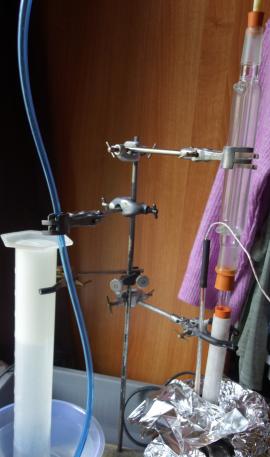
Here is a picture of the acetophenone beginning to distil over, the same Liebig condenser that was used for the refluxing (first picture) is just
visible here on the left, leading into the receiving flask.
Note the 90 degree glass bend that I made painstakingly from a test-tube!
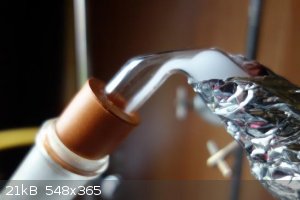
Here is another picture, of a later stage of the distillation.
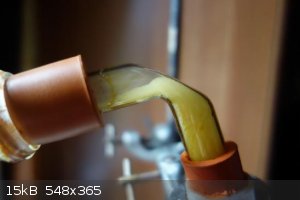
A Bunsen burner was used to heat the tube throughout the process, the tube was glowing red-hot at certain stages...
|
|
|
kmno4
International Hazard
    
Posts: 1495
Registered: 1-6-2005
Location: Silly, stupid country
Member Is Offline
Mood: No Mood
|
|
It is obvious, that such highly simplified test-tube scale procedure creates many problems with foaming, melting and solidifying. It may work well
with lower-boiling products, but it is rather an exception than a rule. Especially it is hard to obtain uniform and constant temperature inside a
test-tube using Bunsen burner etc.
Besides, temperature of decomposition of metal carboxylates depends strongy on metal cation. In the same way, product distribution depends strongly on
cation and temperature. Much better would be some metal retort... etc.
That is why, even for smaller amounts, it is worth to construct simple all-glass pipe reactor, containing metal oxide on some support (pumice,
activated carbon... etc) with electric heating. The same filling can be used for many mixtures of acids. However, it is no more amateur Ca salts
pyrolysis 
[Edited on 17-7-2023 by kmno4]
Слава Україні !
Героям слава !
|
|
|
kmno4
International Hazard
    
Posts: 1495
Registered: 1-6-2005
Location: Silly, stupid country
Member Is Offline
Mood: No Mood
|
|
| Quote: | | .... simple all-glass pipe reactor, containing metal oxide ..... |
It was constructed and tested for propiophenone (=PP) synthesis purpose - just for fun, to see if it was worth of this effort 
Several catalysts were tested (on pumice) : Mg, Mn, Nd and Zn.
The fun was really great and very instructive.
A mixture 1:3 m/m of benzoic acid / propionic acid was used each time. Unfortunately, this mixture requires additional heating, because below ~50 C
benzoic acid separates.
Performance of all but Zn catalysts were similar : 70-80 % of distilled PP was obtained (the yield includes recovered benzoic acid). Nd catalyst
should be operated at higher temperature (420-450 C ), because when temperature is lower, benzoic acid comes mostly unchanged. Mg and Mn can be
operated slightly below 400 C. Do not try Zn : the yield below 10 %, with many additional problems.
But one thing makes me worry : prepared PP and distilled in rather narrow range 215-216 C has sligthy green coloration, This PP was additionally
distilled with steam, but this color is still present. How to remove this green impurity (and what can it be) ? Any tips ?
Слава Україні !
Героям слава !
|
|
|
Pumukli
National Hazard
   
Posts: 689
Registered: 2-3-2014
Location: EU
Member Is Offline
Mood: No Mood
|
|
KMnO4,
Interesting what you wrote about the all-glass reactor. Could you make a picture or make a crude drawing of it?
How did you feed the reactants? From a heated dropping funnel? Or the vapours were fed from below from a flask?
Have you tried coarse, seeved CaCO3 as catalyst?
[Edited on 31-8-2023 by Pumukli]
|
|
|
| Pages:
1
2 |
|